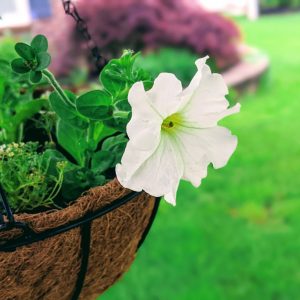How to Propagate Coral Bells (Heuchera) – 2 Easy Methods!
Carefree and popping with hot pink, the coral bells my mother-in-law gave us when we bought our own home keep on delivering. Learn how to propagate coral bells (Heuchera) using these two simple methods!
By the way, I totally ended up writing this post because I accidentally ripped out some coral bells while weeding the other day.

Not wanting them to perish, I stuck them in some water to see what happened. Turned out, the coral bells are naturals at propagating!
Their leaves stayed beautiful and green, and roots formed much quicker than I expected.
Now, you can also learn how to propagate coral bells just as quickly and easily!
Here are my two favorite methods for multiplying Heuchera.
Propagating Coral Bells in Water
Rooting coral bells in a jar of water turned out to be an effortless venture! You can complete this plant propagation in about a minute flat!

Follow these steps to propagate Heuchera in water:
- Obtain a Heuchera cutting by removing a small piece of the coral bell plant. Make sure to get at least a small piece of the tuber and not just stems.
- Stick the bottom of the plant with the tuber in a shallow jar of cool, clean water.
- Sit the jar with the coral bell cuttings in a safe place. We stuck ours on the countertop in the kitchen where it would still receive indirect sunlight.
- Change the water every few days and look for signs of growth. Soon you should notice white roots growing from the base of the cuttings.
- When you see the roots, you can gradually transfer some soil into the water. Consider using a plastic container at this point.
- Once the mixture is more soil than water, you should be able to harden off the plant and transfer it outdoors.

Dividing Coral Bells for Propagation
Perhaps the easiest coral bell propagation method off all, try dividing Heuchera.
Simply remove a piece of your existing plant and baby it until it is fully self-sufficient on its own.
- When digging in the garden, use a hori hori garden knife or other tool to cut away a healthy section of Heuchera. You might also be able to just break a piece off with your hands, but be gentle. And, make sure this piece has roots!
- Immediately transplant the coral bells to another place in the garden or to a flower pot or nursery pot.
- Water the transplanted Heuchera to help the plant acclimate to its new location.
I was able to share a small chunk of my mother-in-law’s coral bells with my bestie and I am not exaggerating when I tell you they are absolutely thriving!
Just a few years later and hers actually look healthier and happier than most of mine!
So yes, transplanting coral bells after dividing can be a very successful propagation tactic.

Coral Bell Propagation Tips
To help your Heuchera with the best chance of survival after propagation, try these tips:
- When transplanting coral bells, be sure to do so on a cloudy, cooler day if possible.
- When propagating Heuchera in water, make sure the clumps of cuttings you take also include some of the tuber, not just stems.
- Consider saving seeds! If your coral bells bloom and produce seeds, it won’t hurt to try growing coral bells from seed in the meantime. This would be a great 3rd propagation method.

Caring for Propagated Coral Bells
If you are reading this after successfully propagating coral bells, congratulations! I’m so happy for your success.
(If you’re reading ahead, I am sure you will be ready for these steps super soon! Fingers crossed for your cuttings or divisions to take!)
Here are some tips to help ensure the successful acclimation of your coral bells after propagation.
Watering
- Water adequately and regularly.
- Dampen the soil as needed but make sure it is not waterlogged.
- Also, avoid letting the soil dry out completely.
Light
- Provide sufficient light.
- Locate the propagated plants in a spot that gets indirect but bright light.
- For the most part, avoid exposing brand-new plant props to direct sunlight, as it can scorch the delicate leaves.
Temperature
- Watch the weather and protect propagated coral bells from extreme temperatures.
- Also avoid exposing these delicate plants to extreme heat or cold.
- If needed, provide protection, especially during their initial growth stages, to avoid heat stress or frost exposure and so forth.
Watch the plants for signs of growth and signs of stress to gain an idea of how successful your propagation may be.

FAQ
Do you have any questions on propagating Heuchera or any stories or tips to share? Feel free to hit us up in the comments below. We love hearing from you!
Happy Gardening!






